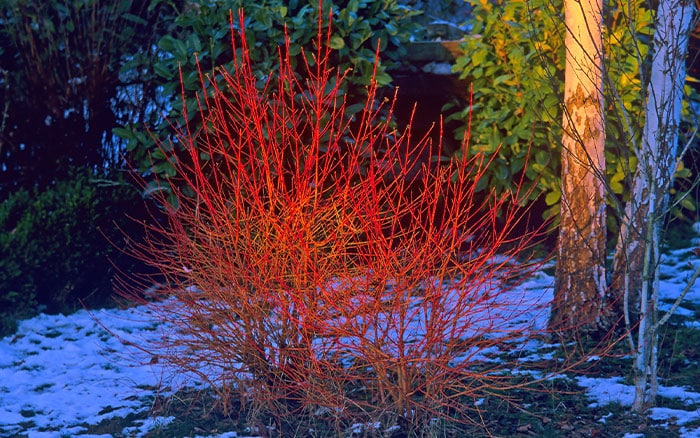The Cornus genus is made up of between 30 – 60 species of trees and shrubs, and they are most commonly known as dogwood. Some have winter flowers, whilst others are most well-known for their striking stem colour during winter.
The beauty of cornus is that there are so many different types with different points of interest that in every single month of the year, at least one of them will have something to offer your garden.
Growing dogwood
The best time to plant bare-root dogwood is in autumn, although it can be planted at any point between October and April. On the other hand, pot-grown dogwoods can be planted all year round.
When planting, ensure the soil is well-prepared with well-rotted organic matter. The type of plant will determine the position and conditions it needs.

For example, winter stem colour dogwood such as Cornus alba ‘Sibirica’ or Cornus sericea ‘Flaviramea’ need a spot in full sun with moist but well-drained soil.
Meanwhile, Cornus mas (Cornelian cherry) is a shrub or small tree that likes full sun or partial shade and neutral or slightly acidic soil.
Caring for dogwood

Cornus trees are pretty low maintenance and don’t demand a lot. They won’t need any pruning apart from pruning lower branches to create a clear and visible trunk.
Another plus is that they are trouble free in regard to pests and disease. But if you do run into problems such as disappointing colour shows during winter, it may be down to their positioning. To get vibrant stems through winter, they’ll need plenty of sun, so if they’re in a shaded spot or are sheltered by other foliage, this can lead to poor colour.
Then, come March, it’s ideal to cut back stems to encourage new growth because the new stems are the ones that will provide that showstopping colour.
Types to try
Cornus sanguinea ‘Midwinter Fire’
Growing up to 2m tall, the orange-red stems of ‘Midwinter Fire’ have the brightest colour through winter. Though the stems are the star of the show, the white, insignificant flowers bloom in summer and are popular with pollinators.
- Interesting stem colour and flowers in summer
- Fully hardy
- Grows up to 2.5m tall
- Moist but well-drained or well-drained soil
- Full sun or partial shade
- Exposed or sheltered

Cornus controversa (wedding cake tree) ‘Variegata’
The tiered branches of this type give it the common name, the wedding cake tree. The variegated leaves are dark green with cream margins that turn yellow in autumn. Then, white clusters of flowers join the leaves which add fluffy texture.
- Flowers in summer
- Hardy
- Grows up to 8m tall
- Moist but well-drained or well-drained soil
- Full sun or partial shade
- Exposed or sheltered

Cornus kousa (Japanese dogwood) ‘Miss Satomi’
The dark pink bracts bring lovely colour during summer, and mature plants provide added interest when they grow strawberry-like fruits after flowering. The leaves turn from dark green to burgundy in autumn, making them great for year-round interest.
- Flowers in summer
- Fully hardy
- Grows up to 7m tall
- Moist but well-drained or well-drained soil
- Full sun or partial shade
- Sheltered or exposed


Leave A Comment